Exploring the London 2012 National Hospitality Houses
The London 2012 Olympics—what an exciting place to be! The two of us (Sulagna Misra and Kia Hays, MPD class of 2013) were able to experience this first hand. We traveled to London during the Olympics as a part of Sulagna’s final practicum project, which is a short interview-based documentary on Olympic fans. While there, we found that some of the most intriguing settings were the National Hospitality Houses scattered throughout the city.
The National Hospitality Houses (NHHs) were pubs, museums, historic buildings, and parks that national Olympic committees rented for the duration of the games to ...what? Well, the problem with describing all these houses is that they all had different purposes. Some, such as the USA hospitality house, were not open to the public. The USA house was set up specifically for athletes, their friends and families, and the American diplomatic community to gather and watch the Games. At the handful of public houses, the atmosphere was also diverse. Some public houses were clearly set up so that citizens from that country and supporters of that team could watch the Games together on a non-BBC channel (because of this, we were able to watch parts of the Games on four different networks aside from BBC or NBC—quite the experience). Others were clearly focused on taking advantage of the opportunity the Games provided to carry out a nation-branding campaign to the many international visitors London hosted. Whatever the intent, these houses truly did represent their countries and people to a wide audience. Here are a few observations we noted along the way.
The Africa Village was an NHH hosted by the ANOCA (Association of the National Olympic Committees of Africa). Unlike most of the other houses, at the Africa Village (located in Hyde Park) a variety of countries had exhibits under one “roof”. Some had cultural displays such as art (Morocco), photography (Libya), and dance (Nigeria). Others, like Tunisia, exalted specific athletes. There were also places to buy food specific to various African countries. The Africa Village used the Olympics as a chance to create a cultural expo of sorts for interested visitors, highlighting non-sport aspects of the many African countries represented in the Olympics. Unfortunately, when we returned on the last day of the Games for a second village, we found that the Africa Village had unexpectedly closed early-something that could carry a negative effect.
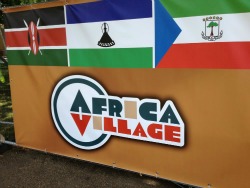
The entrance to the Africa Village. © Sulagna Misra
Next door to the Africa Village was the Russia House, Russia.Sochi.Park. This house was one of the most elaborate of all the ones that we were able to visit. A good majority of the house was devoted to introducing visitors to Sochi, the Russian Winter Olympic 2014 host city. Visitors started their tour with a short video of former Russian Olympians describing what “their Russia” is and inviting the viewer to come visit in two years. After, the visitors proceeded through an elaborate set of displays about Sochi and Russia (much emphasis was given to the “green” design of the 2014 Games) to the Russia Park. The Russia Park was complete with free candy, beanbag chairs, and a skating rink where Russian figure skaters gave performances. This was a clear branding campaign on the part of Russia, which is trying to make itself more attractive to the international public as it takes on the task of hosting not just the 2014 Olympic Games, but also the 2018 FIFA World Cup. Did it work? The displays and workers were both interactive and informative, and although the “Russia is great, come visit” message was a bit heavy-handed, we left impressed.
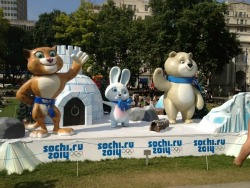
Sochi 2014 mascots. © Kia Hays

Inside the Russia House. © Sulagna Misra
In juxtaposition to the Russia House, Casa Brasil was much less aggressive with its “visit us, we’re hosting the Olympics too!” campaign. In fact, Rio 2016 was not even an emphasis at the house. Instead, Casa Brasil was more comparable to the Africa Village with its emphasis on culture. One of the highlights of this house was its nightly screenings of Brazilian films. That the strategy from the nations of the next two Olympic host cities is different is not surprising, because there are two different end-goals in mind. Russia’s short-term goal is to attract as many international visitors as possible to its upcoming sporting events; Brazil, on the other hand, has a long-term goal. Rio, unlike Sochi, is already a popular destination location for many; therefore, instead of providing reasons why international visitors should visit during a specific event, Brazil focused on educating interested viewers about its rich culture.
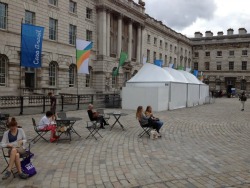
Outside Casa Brasil. © Sulagna Misra
The Irish House was vastly different from the three houses previously mentioned. At a much smaller venue - a pub near King’s Cross Station - the house was nevertheless packed day and night – even with people waiting through the rain. While there were cultural performances such as Irish folk-dancing, most of the people at the House were Irish and had come to watch the Irish team compete on an Irish television channel. But perhaps elaborate displays aren’t always needed to optimize a nation branding campaign—the crowds of friendly people willing to talk over a Guinness or two were enough to leave a lasting positive impression on those visiting the house who were not Irish.
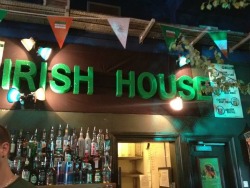
Inside the Irish House. © Kia Hays
Although this was our experience and not the experience of all visitors, the French House was difficult to enter–first because of the long line, and second because when we went to the security guard to ask about the wait, he said, “No English, speak French!” and promptly ignored us. Just as with the Irish House, it was people and not displays and events that created a lasting impression—unfortunately, the French did not make a good one.
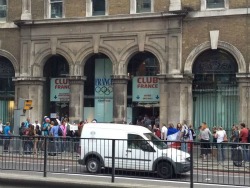
The line at the French House. © Kia Hays
The Holland Heineken House was popular, and we were told by people we spoke with from various countries that it was an NHH we should not miss. Once we arrived at the house, very few patrons were dressed in any other color but orange, and we even got into the contagious spirit and bought orange shirts from the gift shop for ourselves. There was good food, beer, and people from all over the world who had come to have a good time and watch the Olympics on the huge screens around the venue.
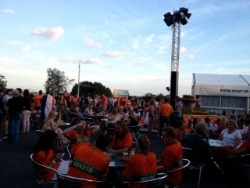
The Dutch Heineken House. © Kia Hays
These are just a few of the many National Hospitality Houses that were around London. We found these houses to be great places to meet people from all around the world, learn more about different cultures and countries, and indulge in delicious food. But they reminded us of many discussions that we have had in public diplomacy classes: How do you evaluate the effectiveness of these houses? And how does an institution or nation effectively reach out to its audience when branding? For example, is Sochi Park’s elaborate and impressive – if propagandistic - display really going to encourage people to visit Russia in 2014 or 2018? Did the houses that emphasized culture and the arts have more or less of an impact than the ones which had beer and large television screens? Whatever the answer, it is clear that there are many nations and national Olympic committees that realize the importance of such an international event and go beyond the track, field, and pool to further engage the Olympic audience.
Tags
Issue Contents
Most Read CPD Blogs
-
November 3
-
November 5
-
November 13
-
November 25
-
December 17
Visit CPD's Online Library
Explore CPD's vast online database featuring the latest books, articles, speeches and information on international organizations dedicated to public diplomacy.








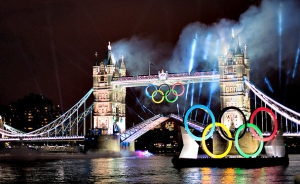
Add comment